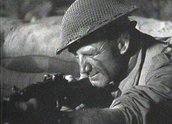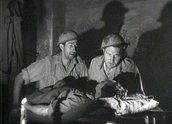


The Rats of Tobruk (1944)
Synopsis
As war breaks out in Europe in 1939, three friends droving cattle in Australia decide to join up. By 1941, they’re with the 9th Division of the Australian Infantry Force, fighting Italians and Nazis in North Africa. Bluey Donkin (Grant Taylor) is an exuberant and restless type, not yet ready to settle down and marry his farm-girl sweetheart, Kate Carmody (Pauline Garrick). Milo Trent (Chips Rafferty) is tall, easygoing, and loyal. The third man, Peter Linton (Peter Finch), is a poetic and romantic Englishman who keeps a diary of his adventures. After early successes, the allied force – 15,000 Australians and 8,000 British and Indians – are dug in at Tobruk, on the coast of Libya. Despite daily air raids they are able to enjoy the amenities of the town, such as a bath and a shave, delivered by the regimental barber (George Wallace).
In armoured patrols in the desert, all three soldiers are injured. They recover in time for Field Marshall Erwin Rommel’s major attacks on Tobruk in March and April 1941. The fighting is fierce and at close range. Rommel’s tanks are disabled and destroyed, and his infantry is unable to penetrate the formidable defences of Tobruk, even though they outnumber the allies by seven to one. In terrible conditions, the allies repel attack after attack for eight long months. Peter Linton is fatally wounded, dying in the presence of his two closest comrades. Bluey and Milo are eventually relieved and sent home to an heroic welcome. A few months later, they are sent to fight in the jungles of New Guinea. Bluey is wounded by a sniper while on patrol. Milo drags him to a riverbank, where he himself is shot and killed. Bluey finds the sniper and kills him with his bare hands. After his wounds heal, Bluey returns to Australia, determined to marry the girl he left behind.
Curator’s notes
The Rats of Tobruk may not be Charles Chauvel’s best movie, but it deserves serious consideration as his best movie about war – which is to argue that it is in some ways superior to his more famous and better-loved Forty Thousand Horsemen (1940), made four years earlier. Horsemen is a more entertaining and better constructed film, fully deserving of its place in the Australian pantheon, but The Rats of Tobruk gives us a better depiction of its subject – the grim, dusty, desperate siege of Tobruk in Libya in 1941, during which a combined force of British, Indian and Australian troops held off Rommel’s Afrika Korps for eight months.
This was Chauvel’s second go at depicting desert warfare and he improves on Forty Thousand Horsemen (1940) in a couple of significant ways. The recreation of the charge of the Light Horse at Beersheba in 1917, the climax of Horsemen, was close to Chauvel’s heart, as the Australians then were commanded by his uncle, Sir Harry Chauvel. Charles Chauvel was also an expert horseman, but the fighting at Tobruk is without horses. Chauvel has tanks, infantry, artillery and dust to work with, but he makes great use of all the elements of the battle. These scenes in The Rats of Tobruk are amongst the best set pieces in his body of work. Charles and his wife Elsa spent a year researching the fighting at Tobruk; they had direct access to soldiers who had fought there, since the 9th Division was back in Australia by February 1943, six months before filming began.
Chauvel based many of the incidents in the film on fact, grafting these onto a structure that’s basically the same as the one he used in Forty Thousand Horsemen (1940): three chums go to war, only one comes back. He even used two of the same actors (Chips Rafferty and Grant Taylor) and the same sand dunes at Cronulla, on the southern outskirts of Sydney, for some of the desert locations.
The difference between the wars in the two films is not just the different times in which they are set. The Rats of Tobruk is a much more personal and ground-level view of war – indeed, much of it is below ground level, from the viewpoint of men in foxholes and dugouts. The fighting is much more graphic, often hand-to-hand, and convincingly chaotic. Death and injury are frequent on both sides and Chauvel disrupts audience expectations that the main characters will survive, when he allows the character played by Peter Finch to die in the battle for Tobruk. He did a similar thing in Forty Thousand Horseman (1940), which suggests that he was impatient with the simple heroes of many Hollywood war films.
The Rats of Tobruk is certainly a work of propaganda, and Chauvel could never have secured funding and permission for anything else in 1943, but it’s also a film that tries to tell some truths about the war. The spirit and tone are more rueful than four years earlier, and far less romantic. The attempts at comedy fall flat, probably because there wasn’t much to laugh about in the news coming back to Australia. Australians were still fighting and dying in the Middle East and Europe, and many of the soldiers who survived Tobruk were now dying in Papua, fighting the Japanese, a fact that provides the film’s unexpected third act, where the action switches from desert to jungle warfare. In the context of wartime, The Rats of Tobruk is certainly meant as a tribute to the exploits and courage of the Australian fighting forces, but it falls somewhat short of being a recruiting film. Both of Chauvel’s war films show that men die in war, even the men cast as heroes. Forty Thousand Horsemen (1940) is the more romantic film about war, The Rats of Tobruk the more realistic.
- Overview
- Curator’s notes
- Video 3 clips
- Principal credits
- Find a copy
- Make a comment
- Map
- Add your review



